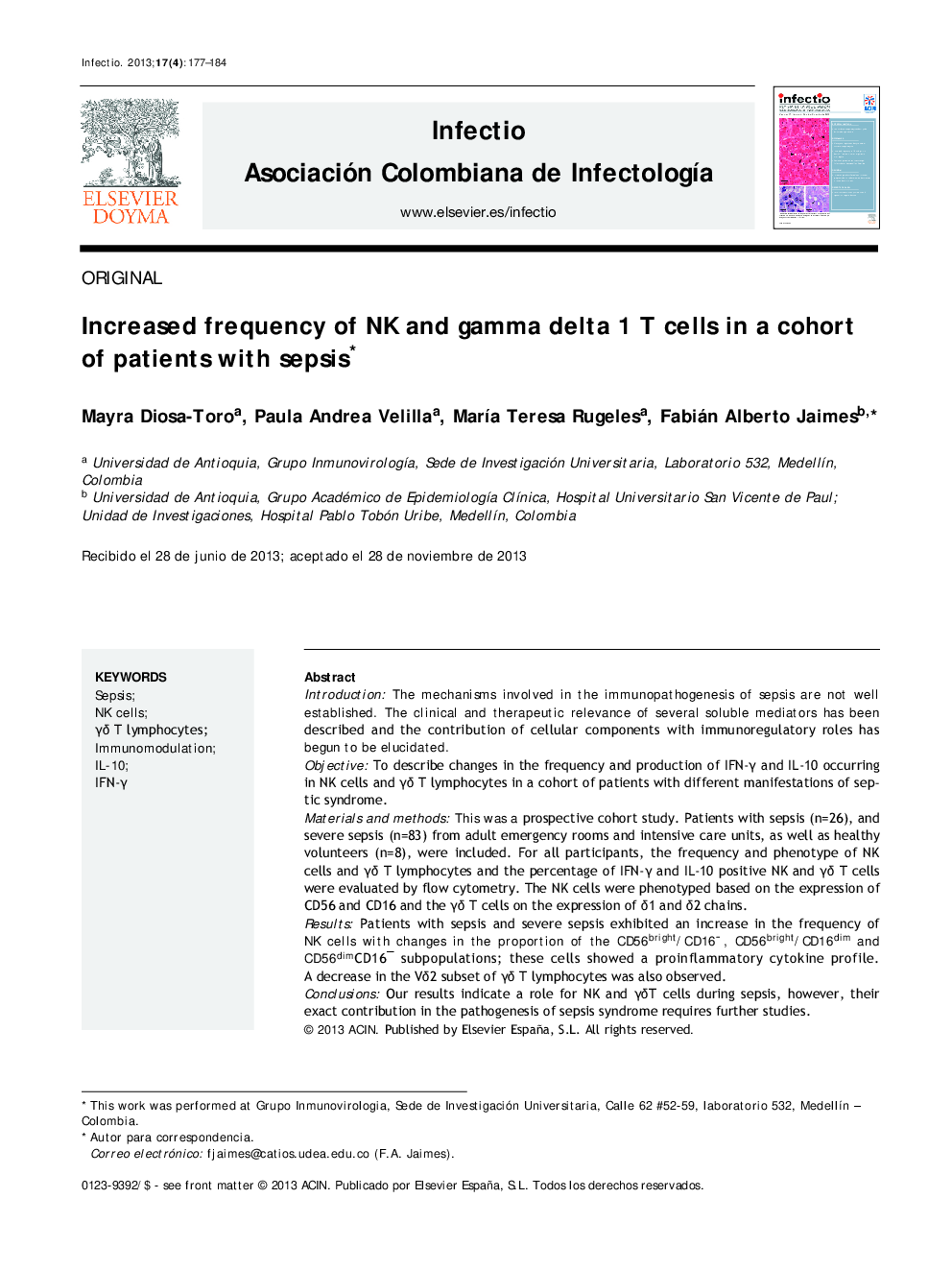| Article ID | Journal | Published Year | Pages | File Type |
|---|---|---|---|---|
| 3403711 | Infectio | 2013 | 8 Pages |
IntroductionThe mechanisms involved in the immunopathogenesis of sepsis are not well established. The clinical and therapeutic relevance of several soluble mediators has been described and the contribution of cellular components with immunoregulatory roles has begun to be elucidated.ObjectiveTo describe changes in the frequency and production of IFN-γ and IL-10 occurring in NK cells and γδ T lymphocytes in a cohort of patients with different manifestations of septic syndrome.Materials and methodsThis was a prospective cohort study. Patients with sepsis (n = 26), and severe sepsis (n = 83) from adult emergency rooms and intensive care units, as well as healthy volunteers (n = 8), were included. For all participants, the frequency and phenotype of NK cells and γδ T lymphocytes and the percentage of IFN-γ and IL-10 positive NK and γδ T cells were evaluated by flow cytometry. The NK cells were phenotyped based on the expression of CD56 and CD16 and the γδ T cells on the expression of δ1 and δ2 chains.ResultsPatients with sepsis and severe sepsis exhibited an increase in the frequency of NK cells with changes in the proportion of the CD56bright/CD16−, CD56bright/CD16dim and CD56dimCD16− subpopulations; these cells showed a proinflammatory cytokine profile. A decrease in the Vδ2 subset of γδ T lymphocytes was also observed.ConclusionsOur results indicate a role for NK and γδT cells during sepsis, however, their exact contribution in the pathogenesis of sepsis syndrome requires further studies.
ResumenIntroducciónLos mecanimos involucrados en la inmunopatogénesis de las sepsis no han sido claramente establecidos. La importancia clínica y terapéutica de diferentes mediadores solubles ha sido descrita y la contribución de componentes celulares con propiedades inmunorreguladoras ha empezado a dilucidarse.ObjetivoDescribir los cambios en la frecuencia y en la producción de IFN-γ e IL-10 que se observa en células NK y linfocitos T γδ en una cohorte de pacientes con diferentes manifestaciones del síndrome séptico.Materiales y métodosEstudio de cohorte prospectiva, donde pacientes con sepsis (n = 26) y sepsis grave (n = 83) provenientes de las salas de emergencias y unidades de cuidado intensivo, y controles sanos (n = 8) fueron incluidos. Tanto la frecuencia y fenotipo de las células NK y T γδ como el porcentaje de células IFN-γ+ e IL-10+ fueron evaluados mediante citometría de flujo. Las células NK fueron fenotipificadas con base en la expresión de las moléculas CD56 y CD 16 y los T γδ con base en la expresión de las cadenas δ1 y δ2.ResultadosEn los pacientes con sepsis y sepsis grave se observó un incremento en la frecuencia de las células NK con cambios en las proporciones de las subpoblaciones CD56bright/CD16−, CD56bright/CD16dim y CD56dimCD16−; en estas células se observó un perfil de citocinas proinflamarias. Se observó una reducción en el porcentaje de células Vδ2.ConclusionesLos resultados sugieren un papel de las células NK y linfocitos T γδ durante la sepsis; sin embargo, su contribución en la patogénesis de este síndrome requiere estudios adicionales.
